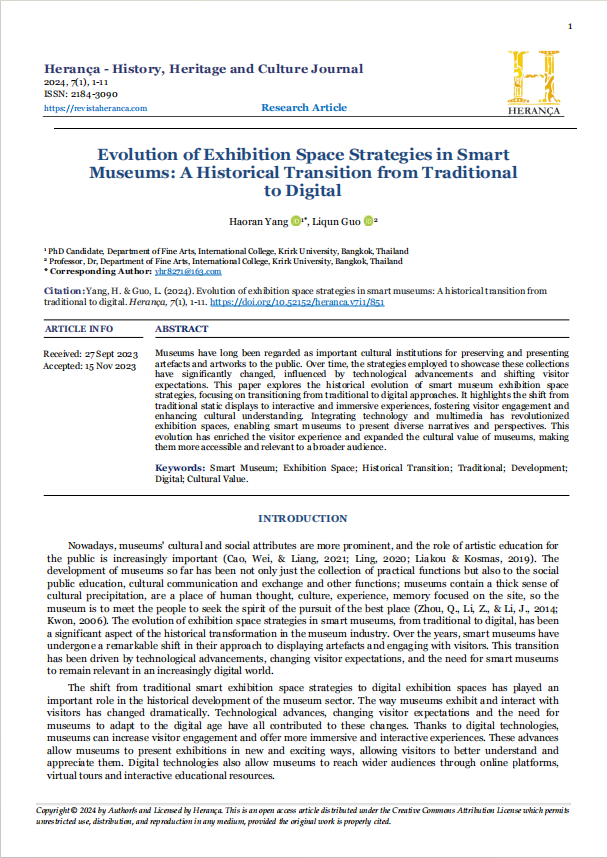Evolution of Exhibition Space Strategies in Smart Museums: A Historical Transition from Traditional to Digital
DOI:
https://doi.org/10.52152/heranca.v7i1.851Palavras-chave:
Smart Museum, Exhibition Space, Historical Transition, Traditional, Development, Digital, Cultural ValueResumo
Museums have long been regarded as important cultural institutions for preserving and presenting artefacts and artworks to the public. Over time, the strategies employed to showcase these collections have significantly changed, influenced by technological advancements and shifting visitor expectations. This paper explores the historical evolution of smart museum exhibition space strategies, focusing on transitioning from traditional to digital approaches. It highlights the shift from traditional static displays to interactive and immersive experiences, fostering visitor engagement and enhancing cultural understanding. Integrating technology and multimedia has revolutionized exhibition spaces, enabling smart museums to present diverse narratives and perspectives. This evolution has enriched the visitor experience and expanded the cultural value of museums, making them more accessible and relevant to a broader audience.
Downloads
Referências
Cao, K., Wei, C., & Liang, Q. (2021). Research on the "Shape" Design method of museum exhibition space under the background of new media art. In Proceedings of 4th International Workshop on Education Reform and Social Sciences (ERSS 2021) (pp.57-72). https://doi.org/10.54691/bcpssh.v14i.167
Ciolfi, L., & Bannon, L. J. (2007). Designing hybrid places: merging interaction design, ubiquitous technologies and geographies of the museum space. CoDesign, 3(3), 159-180.
Claisse, C., Petrelli, D., Ciolfi, L., Dulake, N., Marshall, M. T., & Durrant, A. C. (2020). Crafting critical heritage discourses into interactive exhibition design. In Proceedings of the 2020 CHI Conference on Human Factors in Computing Systems (pp. 1-13). https://doi.org/10.1145/3313831.3376689
Gautrand, M. (2015). Museum architecture and interior design. Hong Kong, China: Design Media Publishing Limited.
Greenberg, R., Ferguson, B. W., & Nairne, S. (Eds.). (1996). Thinking about exhibitions. New York, NY: Psychology Press.
Hall, M. (1988). On display: A design grammar for museum exhibitions. Museum International, 40(2), 119-119.
Kwon, Y. G. (2006). A study on the methodology of color planning in museum exhibition space. 한국색채학회 학술대회, 109-112.
Liakou, M., & Kosmas, O. (2019). Analyzing museum exhibition spaces via visitor movement and exploration: The case of Whitworth Art Gallery of Manchester. Journal of Physics: Conference Series, 1391(1), 012171.
Ling, W. (2020). Research on the expression of regional cultural elements in the design of museum exhibition space. Frontiers in Art Research, 2(8).
Macdonald, S. (2007). Interconnecting: museum visiting and exhibition design. CoDesign, 3(S1), 149-162.
MacLeod, S., Dodd, J., & Duncan, T. (2015). New museum design cultures: harnessing the potential of design and ‘design thinking’ in museums. Museum Management and Curatorship, 30(4), 314-341.
Stamatopoulou, M. (2016). New museums, exhibitions and site presentations. Archaeological Reports, 62, 45-62.
Teufel, P. (2008). Neue Ausstellungsgestaltung: New exhibition design. In U. J. Reinhardt (Ed.). Avedition. Dusseldorf, German: Exhibition Design Institute Fachhochschule Düsseldorf.
Vishkaie, R., Seyed, T., Emmons, C. T., & vom Lehn, D. (2021). Take me to Greece: Exploring intergenerational interactivity in a mixed reality children's museum exhibition. Journal of Museum Education, 46(1), 93-112.
Zhou, Q., Li, Z., & Li, J. (2014). Museum exhibition space analysis based on tracing behavior observation. Applied Mechanics and Materials, 477, 1140-1143.

Downloads
Publicado
Como Citar
Edição
Secção
Licença
Direitos de Autor (c) 2023 Herança - Revista de História, Património e Cultura

Este trabalho encontra-se publicado com a Licença Internacional Creative Commons Atribuição 4.0.






8.png)





